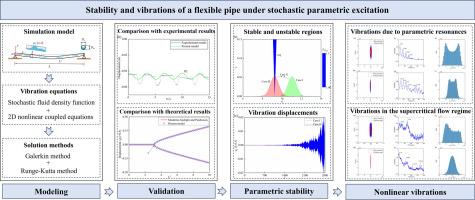随机参数激励下挠性管道的稳定性与振动
IF 9.4
1区 工程技术
Q1 ENGINEERING, MECHANICAL
International Journal of Mechanical Sciences
Pub Date : 2025-09-27
DOI:10.1016/j.ijmecsci.2025.110895
引用次数: 0
摘要
柔性管道广泛应用于天然气、石油等气液两相流的输送。这两种流体相(气相和液相)的自然分离、变形和混合会导致总流体密度的时空随机变化。本文采用基于高斯分布的数学模型来模拟气液两相流中流体密度的随机波动。随后,研究了输送气液两相流的柔性管道的横向和轴向非线性耦合振动。采用伽辽金法结合龙格-库塔法求解管道振动方程。在验证该动力学模型的基础上,对气液两相流动随机流体密度对管道稳定性和振动特性的影响进行了全面分析。结果表明,利用Floquet理论可以确定管道的参数稳定性和不稳定性。如果随机流体密度的任意频率分量的状态转移矩阵特征值大于1,则管道系统变得不稳定。在亚临界流态下,气液两相流参数共振引起的管道振动表现出混沌特征,而在超临界流态下,由于管道屈曲失稳引起的振动也表现出混沌特征。本文章由计算机程序翻译,如有差异,请以英文原文为准。

Stability and vibrations of a flexible pipe under stochastic parametric excitation
Flexible pipes are widely used in engineering applications to transport gas-liquid two-phase flows, such as natural gas and oil. The natural separation, deformation, and mixing of these two fluid phases (gas and liquid) can cause spatiotemporal stochastic variations in total fluid density. In this paper, a mathematical model based on the Gaussian distribution is employed to simulate the stochastic fluctuations in the fluid density of gas-liquid two-phase flow. Subsequently, the nonlinear coupled transversal and axial vibrations of a flexible pipe conveying gas-liquid two-phase flow are developed. The pipe vibration equations are solved using the Galerkin method combined with the Runge-Kutta method. After validating the proposed dynamic model, a comprehensive analysis of the stability and vibration characteristics of the pipe induced by the stochastic fluid density of gas-liquid two-phase flow is conducted. The results indicate that the parametric stability and instability of the pipe can be determined using the Floquet theory. If any frequency component of the stochastic fluid density has a state transition matrix eigenvalue greater than one, the pipe system becomes unstable. In the subcritical flow regime, the pipe vibrations caused by parametric resonances of gas-liquid two-phase flow exhibit chaotic behavior, while in the supercritical regime, the vibrations also display chaotic characteristics due to pipe buckling instability.
求助全文
通过发布文献求助,成功后即可免费获取论文全文。
去求助
来源期刊

International Journal of Mechanical Sciences
工程技术-工程:机械
CiteScore
12.80
自引率
17.80%
发文量
769
审稿时长
19 days
期刊介绍:
The International Journal of Mechanical Sciences (IJMS) serves as a global platform for the publication and dissemination of original research that contributes to a deeper scientific understanding of the fundamental disciplines within mechanical, civil, and material engineering.
The primary focus of IJMS is to showcase innovative and ground-breaking work that utilizes analytical and computational modeling techniques, such as Finite Element Method (FEM), Boundary Element Method (BEM), and mesh-free methods, among others. These modeling methods are applied to diverse fields including rigid-body mechanics (e.g., dynamics, vibration, stability), structural mechanics, metal forming, advanced materials (e.g., metals, composites, cellular, smart) behavior and applications, impact mechanics, strain localization, and other nonlinear effects (e.g., large deflections, plasticity, fracture).
Additionally, IJMS covers the realms of fluid mechanics (both external and internal flows), tribology, thermodynamics, and materials processing. These subjects collectively form the core of the journal's content.
In summary, IJMS provides a prestigious platform for researchers to present their original contributions, shedding light on analytical and computational modeling methods in various areas of mechanical engineering, as well as exploring the behavior and application of advanced materials, fluid mechanics, thermodynamics, and materials processing.
 求助内容:
求助内容: 应助结果提醒方式:
应助结果提醒方式:


